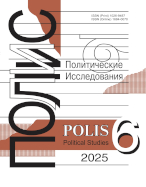Russia and the United States on the world stage. Part I. From distant friendship to incipient rivalry
Graham T.,
Council on Foreign Relations, New York, USA, tgraham@cfr.org
DOI: 10.17976/jpps/2022.01.02
Graham T. Russia and the United States on the world stage. Part I. From distant friendship to incipient rivalry. – Polis. Political Studies. 2022. No. 1. https://doi.org/10.17976/jpps/2022.01.02
The article is a chapter from the book “Russia and the United States on the World Stage”, which is under writing. The editors plan to print other chapters as they become available. The text was written with sympathy for Russia, perhaps the greatest possible for a modern American political thinker. An attentive Russian reader, familiar with historical texture, will undoubtedly note a certain author's subjectivity in the selection of facts and in the preference for interpretations, and will find obvious “figures of silence” at critical points of presentation. But this subjectivity of the author's view seems to be the most valuable to the Editorial Board. This “optics of the Other”, focused on Russian-American relations, gives the Russian reader a chance to critically revise some of his own prejudices regarding the views and motivations of his American colleagues, which is so urgently needed today to restore a full-fledged dialogue. At least in order to suspend further slide into the abyss.
The period from the American War of Independence (1775-1783) to the sale of Alaska (1867) was the longest period of friendly relations in US-Russian history. This was hardly a period of close ties, however, or what we would now call partnership. Each country was of marginal concern to the other. The gulf in values was profound and unbridgeable, even if the two powers insulated relations from ideological disputes. Geopolitical tension was absent because the two countries largely operated in separate spheres. Where they did interact, friction did not erupt into serious conflict, because Russia was willing to accommodate American expansionism rather risk escalation in regions that were far from vital. The benefits that each country derived from the other were minimal and never arose from extensive collaboration. Rather they were the consequence of each country’s refusal to take sides against the other in conflicts with third powers, including the War for Independence, the Crimean War, and the American Civil War. If relations were friendly, it was because there was no compelling reason to be rivals. The situation changed dramatically in the last decades of the 19th century, as the United States experienced an unprecedented period of rapid growth in wealth and power while Russia entered a prolonged period of imperial crisis. American ideological and geopolitical ambition eventually turned distant friendship into an incipient rivalry.
References
Anschel, E. (1974). The American image of Russia, 1775-1917. New York: Frederick Ungar Publishers.
Bolkhovitinov, N. (1971). Russia and the Declaration of the non-colonization principle: new archival evidence. Oregon Historical Quarterly, 72(2), June.
Dulles, F. (1965). Prelude to world power: American diplomatic history, 1860-1900. New York: Collier Books.
Fuller, W.C. (1992). Strategy and power in Russia 1600-1914. New York: The Free Press.
Gaddis, J. (1978). Russia, the Soviet Union, and the United States: an interpretive history. New York: John Wiley and Sons.
Gillard, D. (1977). The Struggle for Asia 1828-1914: A study in British and Russian imperialism. New York: Holmes and Meier Publishers.
Hosking, G. (2001). Russia and the Russians: a history. Cambridge: The Belknap Press.
Kagan, R. (2007). Dangerous nation. New York: Vintage Books.
Kennedy, P. (1987). The rise and fall of the great powers: economic change and military conflict from 1500 to 2000. New York: Vintage Books.
Kupchan, C. (2020). Isolationism: a history of America’s efforts to shield itself from the world. Oxford: University Press.
Saul, N. (1991). Distant friends: the United States and Russia, 1763-1867. Lawrence: University of Kansas Press.
Williams, W. (1971). American-Russian relations 1782-1947. New York: Octagon Books.
Bolkhovitinov, N. (1966). Stanovleniye russko-amerikanskikh otnosheniy. 1775-1815 [The formation of Russo-American relations. 1775-1915]. Moscow: Nauka. (In Russ.)
Bolkhovitinov, N. (1990). Russko-amerikanskiye otnosheniya i prodazha Alyaski. 1834-1867 [Russo- American relations and the selling of Alyaska. 1834-1867]. Moscow: Nauka. (In Russ.)
See also:
Rozov N.S.,
Crisis and Revolutions: Fields of Interaction, Actors’ Strategies, and Trajectories of Conflict Dynamics. – Polis. Political Studies. 2017. No6
Yevzerov R.Ya. ,
World War as the 20th Century Phenomenon. – Polis. Political Studies. 1995. No3
Ilyin M.V.,
The War in Yugoslavia: from Sacrificing Serbia to the Suicide of the West?. – Polis. Political Studies. 1999. No2
Tolipоv F.F.,
The War in Afghanistan and Geopolitical Transformation in Central and South Asia.. – Polis. Political Studies. 1998. No6
Kazarinova D.B.,
Cold War and Peace: “Russia Against the Rest” and Four World Orders of R. Sakwa. – Polis. Political Studies. 2018. No4




.jpg)






 print
print
.jpg)
.jpg)